All the solutions provided in McGraw Hill Math Grade 5 Answer Key PDF Chapter 3 Lesson 1 Relate Division to Multiplication will give you a clear idea of the concepts.
McGraw-Hill My Math Grade 5 Answer Key Chapter 3 Lesson 1 Relate Division to Multiplication
Example 1
Sheryl is helping to put away 18 basketballs after practice. She places them on a rack that has 3 shelves. How many basketballs can she put on each self?

Use a fact family.
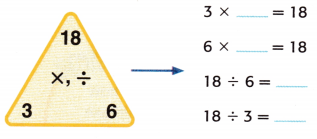
So, 18 ÷ 3 = ___. Sheryl can put ___ basketballs on each shelf.
Check Draw an equal amount of basketballs on each shelf.

___ basketballs on each shelf.
Answer:
6 basketballs.

Explanation:
By using fact family,
3 x 6 = 18
6 x 3 = 18
18 ÷ 3 = 6
So, Sheryl can put 6 basketballs on each shelf.
Example 2
Ellie is creating gift bags for her party guests. She wants to divide 56 pencils equally among the 7 gift bags. How many pencils will go in each bag?

Let p represent the number of pencils in each bag.
____ ÷ ___ = p
Think: What number times 7 is 56?
Write a related multiplication fact
7 × ___ = 56
So, 56 ÷ 7 = ___. Since p = ___, Ellie will put ___ pencils in each bag.
Answer:
8 pencils in each bag.
Explanation:
56 ÷ 7 = 8
7 × 8 = 56
So, Ellie will put 8 pencils in each bag.
Guided Practice
Question 1.
Complete the fact family for 8, 9, 72.

8 × ___ = 72
9 × ___ = 72
___ ÷ 8 = __
___ ÷ 9 = ___
Answer:
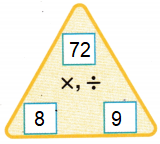
Explanation:
Fact Family is a collection of related multiplication and division facts,
made from the same numbers.
8 × 9 = 72
9 × 8 = 72
72 ÷ 8 = 9
72 ÷ 9 = 8
Talk Math
Describe how you could use multiplication to find 21 ÷ 7 = x.

Answer:
21 ÷ 7 = 3
3 x 7 = 21
7 x 3 = 21
Explanation:
Division by a number is related to multiplication by the same number.
The two related equations are made up of the very same numbers.
Divide. Use a related multiplication fact.
Question 2.
48 ÷ ___ = 6
Think: __ × 6 = 48
Answer:
48 ÷ 8 = 6
Think: 8 × 6 = 48
6 x 8 = 48
Explanation:
Numbers are related when multiply two of them together to get a third number or the product.
No matter what order the two numbers are multiplied, their product remains the same.
Question 3.
40 ÷ 5 = ____
Think: 5 × ___ = 40
Answer:
40 ÷ 5 = 8
Think: 8 × 5 = 40
5 x 8 = 40
Explanation:
Numbers are related when multiply two of them together to get a third number or the product.
No matter what order the two numbers are multiplied, their product remains the same.
Independent Practice
Write a fact family for each set.
Question 4.

____ ____
____ ____
Answer:
3 x 5 = 15
5 x 3 = 15
15 ÷ 5 = 3
Explanation:
A group of related facts using the same number is known as fact family.
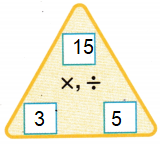
Question 5.

____ ____
____ ____
Answer:
2 x 8 = 16
8 x 2 = 16
16 ÷ 2 = 8
Explanation:
A group of related facts using the same number is known as fact family.
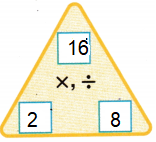
Question 6.
4, 9, 36
_________
_________
_________
_________
Answer:
4 x 9 = 36
9 x 4 = 36
36 ÷ 4 = 9
36 ÷ 9 = 4
Explanation:
A group of related facts using the same number is known as fact family.
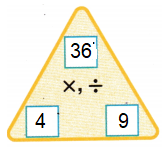
Question 7.
5, 7, 35
_________
_________
_________
_________
Answer:
5 x 7 = 35
7 x 5 = 35
35 ÷ 7 = 5
35 ÷ 5 = 7
Explanation:
A group of related facts using the same number is known as fact family.
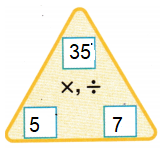
Question 8.
3, 8, 24
_________
_________
_________
_________
Answer:
3 x 8 = 24
8 x 3 = 24
24 ÷ 3 = 8
24 ÷ 8 = 3
Explanation:
A group of related facts using the same number is known as fact family.
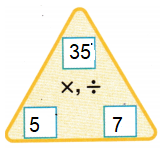
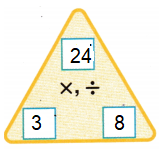
Divide. Write the related multiplication fact.
Question 9.
64 ÷ 8 = ___
___ × 8 = 64
Answer:
64 ÷ 8 = 8
8 × 8 = 64
Explanation:
A multiplication fact is the product of two specific numbers.
And the order in which the numbers are presented does not change the product.
Multiplication facts are often taught as fact families with their opposite operation, division.
Question 10.
45 ÷ 9 = ___
___ × 9 = 45
Answer:
45 ÷ 9 = 5
5 × 9 = 45
Explanation:
A multiplication fact is the product of two specific numbers.
And the order in which the numbers are presented does not change the product.
9 x 5 = 45
5 x 9 = 45
Multiplication facts are often taught as fact families with their opposite operation, division.
Question 11.
__ ÷ 9 = 9
9 × 9 = ___
Answer:
81 ÷ 9 = 9
9 × 9 = 81
Explanation:
A multiplication fact is the product of two specific numbers.
And the order in which the numbers are presented does not change the product.
Multiplication facts are often taught as fact families with their opposite operation, division.
Question 12.
___ ÷ 8 = 4
4 × 8 = ____
Answer:
32 ÷ 8 = 4
4 × 8 = 32
Explanation:
A multiplication fact is the product of two specific numbers.
And the order in which the numbers are presented does not change the product.
4 x 8 = 32
8 x 4 = 32
Multiplication facts are often taught as fact families with their opposite operation, division.
Question 13.
40 ÷ ___ = 8
8 × ___ = 40
Answer:
40 ÷ 5 = 8
8 × 5 = 40
Explanation:
A multiplication fact is the product of two specific numbers.
And the order in which the numbers are presented does not change the product.
8 x 5 = 40
5 x 8 = 40
Multiplication facts are often taught as fact families with their opposite operation, division.
Question 14.
63 ÷ ___ = 7
7 × ___ = 63
Answer:
63 ÷ 9 = 7
7 × 9 = 63
Explanation:
A multiplication fact is the product of two specific numbers.
And the order in which the numbers are presented does not change the product.
7 x 9 = 63
9 x 7 =63
Multiplication facts are often taught as fact families with their opposite operation, division.
Algebra Find the unknown number in each equation. Use a related division fact.
Question 15.
2 × m = 12
m = ____
Answer:
m = 6
Explanation:
To isolate the variable in algebra we use inverse operations to manipulate the equation.
So, multiplication is the inverse of division.
2 × m = 12
m = 12 ÷ 2
m = 6
Question 16.
8 × y = 24
y = ____
Answer:
y = 3
Explanation:
To isolate the variable in algebra we use inverse operations to manipulate the equation.
So, multiplication is the inverse of division.
8 × y = 24
y = 24 ÷ 8
y = 3
Question 17.
9 × g = 72
g = ___
Answer:
g = 8
Explanation:
To isolate the variable in algebra we use inverse operations to manipulate the equation.
So, multiplication is the inverse of division.
9 × g = 72
g = 72 ÷ 9
g = 8
Problem Solving
Algebra For Exercises 18—20, use the information below.
Orange blossoms have 5 petals and are some of the most fragrant flowers.
Question 18.
How many petals would there be in a group of 7 flowers?

Answer:
35 petals.
Explanation:
Orange blossoms have 5 petals.
Number of petals in a group of 7 flowers,
7 x 5 = 35 petals.
35 ÷ 7 = 5 petals.
Question 19.
How many petals p would there be in a group of 11 flowers? Write an equation to find the unknown. Then find the unknown.
Answer:
11 x 5 = p
p = 55 petals.
Explanation:
Orange blossoms have 5 petals.
Number of petals in a group of 11 flowers,
11 x 5 = 55 petals.
55 ÷ 11 = 5 petals.
Question 20.
A group of f flowers has 40 petals in all. Write an equation to find the unknown. Then find the unknown.
Answer:
f x 5 = 40
f = 40 ÷ 5
f = 8
Explanation:
Orange blossoms have 5 petals.
A group of f flowers has 40 petals in all.
Number of flowers in a group are 40 ÷ 5 = 8 groups.
Hot Problems
Question 21.
Mathematical PRACTICE 2 Reason Can the number 12 be part of more than one fact family? Explain.
Answer:
Yes, 12 can be a part of more than one fact family.
Explanation:
The fact family of 12 is as follows,
3 x 4 = 12
6 x 2 = 12
Question 22.
Mathematical PRACTICE 3 Which One Doesn’t Belong? Circle the equation that does not belong with the other three. Explain why it does not belong.
54 ÷ 9 = 6 54 ÷ 6 = 9 9 × 3 = 27 6 × 9 = 54
Answer:

Explanation:
9 x 3 = 27 does not belong to the fact family,
where as the other three belong to the fact family.
Question 23.
? Building on the Essential Question How do multiplication facts help me divide?
Answer:
Recalling tables improves memory skills, which is a transferrable skill that will help children throughout life.
Children will find it easier to solve Math problems
Explanation:
When we divide, we look to separate into equal groups,
while multiplication involves joining equal groups.
Multiplication and division are very closely related.
They are opposite operations.
Division by a number is related to multiplication by the same number.
The two related equations are made up of the very same numbers
McGraw Hill My Math Grade 5 Chapter 3 Lesson 1 My Homework Answer Key
Practice
Write a fact family for each set of numbers.
Question 1.
2, 10, 20
_________
_________
_________
Answer:
2 x 10 = 20
10 x 2 = 20
20 ÷ 2 = 10
Explanation:
A group of related facts using the same number is known as fact family.
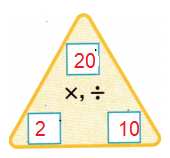
Question 2.
8, 7, 56
_________
_________
_________
Answer:
8 x 7 = 56
7 x 8 = 56
56 ÷ 8 = 7
Explanation:
A group of related facts using the same number is known as fact family.

Question 3.
7, 9, 63
_________
_________
_________
_________
Answer:
7 x 9 = 63
9 x 7 = 63
63 ÷ 9 = 7
63 ÷ 7 = 9
Explanation:
A group of related facts using the same number is known as fact family.

Divide. Write the related multiplication fact.
Question 4.
36 ÷ ___ = 6
6 × ___ = 36
Answer:
36 ÷ 6 = 6
6 × 6 = 36
Explanation:
A multiplication fact is the product of two specific numbers.
And the order in which the numbers are presented does not change the product.
Multiplication facts are often taught as fact families with their opposite operation, division.
Question 5.
77 ÷ 11 = ____
___ × 11 = 77
Answer:
77 ÷ 11 = 7
7 × 11 = 77
Explanation:
A multiplication fact is the product of two specific numbers.
And the order in which the numbers are presented does not change the product.
Multiplication facts are often taught as fact families with their opposite operation, division.
Question 6.
___ ÷ 8 = 12
12 × 8 = ____
Answer:
96 ÷ 8 = 12
12 × 8 = 96
Explanation:
A multiplication fact is the product of two specific numbers.
And the order in which the numbers are presented does not change the product.
Multiplication facts are often taught as fact families with their opposite operation, division.
Mathematical PRACTICE 2 Use Algebra Find the unknown number in each equation. Use a related division fact.
Question 7.
4 × b = 12
b = ____
Answer:
b = 3
Explanation:
To isolate the variable in algebra we use inverse operations to manipulate the equation.
So, multiplication is the inverse of division.
4 × b = 12
b = 12 ÷ 4
b = 3
Question 8.
3 × n = 45
n = ____
Answer:
n = 15
Explanation:
To isolate the variable in algebra we use inverse operations to manipulate the equation.
So, multiplication is the inverse of division.
3 × n = 45
n = 45 ÷ 3
n = 15
Question 9.
6 × k = 18
k = ____
Answer:
k = 3
Explanation:
To isolate the variable in algebra we use inverse operations to manipulate the equation.
So, multiplication is the inverse of division.
6 × k = 18
k = 18 ÷ 6
k = 3
Vocabulary Check
Question 10.
Choose the correct word(s) to complete the sentence below. A group of related facts that use the same numbers is called a(n) _____.
Answer:
Fact family.
Explanation:
A group of related facts using the same number is known as fact family.
2 x 8 = 16
8 x 2 = 16
16 ÷ 2 = 8

Problem Solving
Question 11.
Julian places 8 books on each shelf of a bookcase. If he shelves 32 books, how many shelves are needed?
Answer:
4 shelves.
Explanation:
Julian places 8 books on each shelf of a bookcase.
If he shelves 32 books,
Number of shelves needed 32 ÷ 8 = 4
Question 12.
There are 15 cats ready for new homes at the pet store. There are 5 cages with cats in the store. If each cage has the same number of cats, how many cats are in each cage?

Answer:
3 cats.
Explanation:
There are 15 cats ready for new homes at the pet store.
There are 5 cages with cats in the store.
If each cage has the same number of cats,
Number of cats in each cage 15 ÷ 5 = 3
Question 13.
The leaves of a poison ivy plant are found in clusters of 3. One poison ivy plant has a total of 21 leaves. How many leaf clusters does this plant have?
Answer:
7 clusters of leaves.
Explanation:
The leaves of a poison ivy plant are found in clusters of 3.
One poison ivy plant has a total of 21 leaves.
Number of leaf clusters does the plant have 21 ÷ 3 = 7
Test Practice
Question 14.
A local pet store has a total of 72 fish in 9 tanks. Each tank holds the same number of fish. How many fish are in each tank?
A. 6 fish
B. 7 fish
C. 8 fish
D. 9 fish
Answer:
Option(C)
Explanation:
A local pet store has a total of 72 fish in 9 tanks.
Each tank holds the same number of fish.
Number of fishes in each tank 72 ÷ 9 = 8